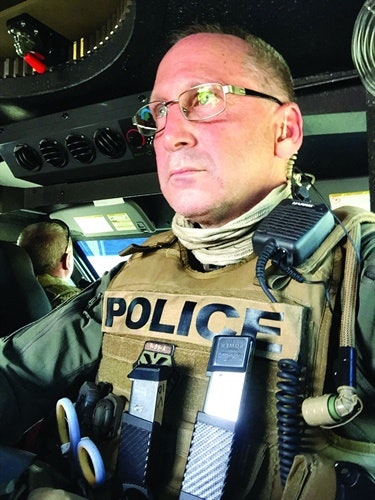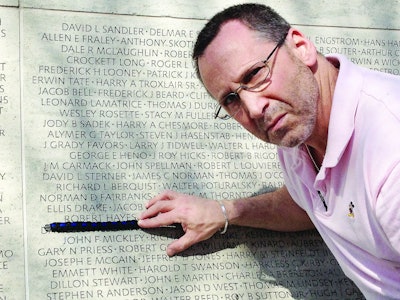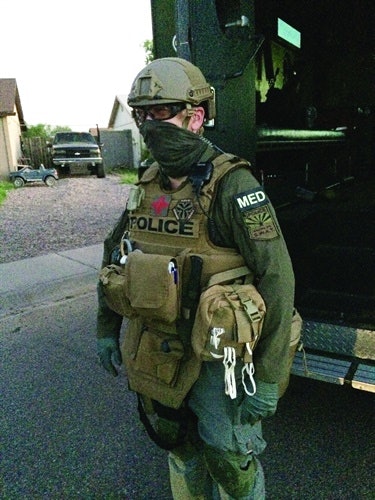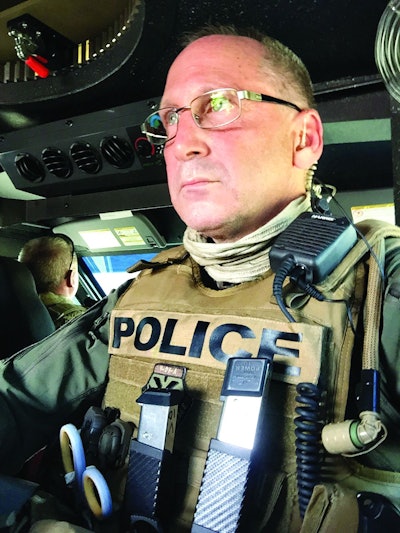
Tactical medicine has come a long way in the last few decades. The concept that was once known as "battlefield medicine" and only practiced in the military is now a mainstay in law enforcement. Today, it's not uncommon for SWAT teams nationwide to deploy with emergency medical personnel. Some of those teams even arrive on scene with physicians. And a few, like the Arizona Department of Public Safety's SWAT team, roll out with a trauma surgeon.
That trauma surgeon on the Arizona DPS team is Dr. Sydney Vail, one of the nation's leading authorities on tactical medicine and the care of gunshot victims. Vail is also an outspoken advocate of all law enforcement officers, and even some members of the public, having access to and knowing how to use tourniquets to stop hemorrhage from critical injuries.
Outspoken also characterizes Vail's views on wound ballistics. His articles—"9mm Vs. .40 Caliber" and "Stopping Power: Myths, Legends, and Realities"—are some of the most popular and most controversial in the history of POLICE Magazine and PoliceMag.com.
Vail, who has studied the performance of handgun ammunition in both the gunshot wound patients he has operated on and in the works of researchers like Dr. Martin Fackler, is a strong believer that size of ammunition used in a handgun has much less effect on stopping a threat than shot placement.
In "Stopping Power" he wrote: "I believe the definition of stopping power should be a particular ammunition's effectiveness to render a person unable to offer resistance or remain a threat to the officer, an intended victim, or self.
"So how does ammunition accomplish this? You have two options. You can use a really large round at very high velocity like the 30mm cannon rounds from an Apache helicopter's M230 Chain Gun, which produces substantial kinetic energy, or you can place your shot where it has the most effect. Obviously, shot placement is the only realistic option for a law enforcement officer."
Vail's argument that the stopping power of handgun ammunition is not based on caliber has elicited howls of protest from members of the firearms community who are devotees of particular cartridges, especially the .45 ACP. Vail says he enjoys the debate and he reads the comments on his articles, but he stands by his conclusions about ammo performance based on his experience as a scientist, a surgeon, a shooter, and a tactical medical provider.
 Dr. Sydney Vail visited the National Law Enforcement Officers Memorial, where he found the name of the one critically injured officer he couldn’t save in surgery, Philadelphia PD Officer Robert Hayes. (Photo Courtesy of Sydney Vail)
Dr. Sydney Vail visited the National Law Enforcement Officers Memorial, where he found the name of the one critically injured officer he couldn’t save in surgery, Philadelphia PD Officer Robert Hayes. (Photo Courtesy of Sydney Vail)
POLICE Magazine editor David Griffith recently spoke with Vail about his career as a trauma surgeon, his experience as a tactical medical provider, his advocacy of tourniquet use, and his study of wound ballistics.
POLICE: What made you choose trauma surgeon as a specialty?
Vail: When I was going through my surgical training early on, it got routine. Trauma is anything but routine. You never know what comes in the door next. It could be a gunshot wound, a stab wound, a terrible car accident. I guess I am an adrenaline junkie. Also, I wanted to use my brain more than just knowing ahead of time what to do. With trauma you have to figure out what to do next as you operate.
POLICE: You've been working with law enforcement since 2002. What got you involved in that?
Vail: When I was a fellow in Miami, one of our faculty was the medical director for Metro Dade County police and fire, and that got me interested. Then, once I heard about tactical medicine, I thought it was a way for me to give back to law enforcement.
POLICE: When you were in Roanoke, VA, you worked on victims of the Virginia Tech active shooter…
Vail: I took care of three or four patients from that. We did not get the majority of patients, but we got the worst of them.
POLICE: Did that teach you anything about what law enforcement can do in the field as far as tactical medical response to improve survivability for the victims of an active shooter?
Vail: I was already working as a tactical medical provider back then and training other tactical medics. It just reinforced for me the value of tactical medicine. One of our tactical medics actually put a tourniquet on a kid who tied a lamp plug cord around his leg to stop the hemorrhage from a femoral artery. Because he was able to go inside with the responding officers and find this patient, and get a tourniquet on him, his life was saved.
POLICE: What's the most important thing an officer can do to improve a person's chance of survival after a major trauma?
Vail: Number one is intervene. Do something. And hopefully, you have the appropriate resources to do the job, meaning have a commercial tourniquet, have combat gauze, so you can take care of a wound: Stop the bleeding.
POLICE: Can the average officer really learn how to control the bleeding of a critically injured person in the field?
Vail: Anybody can learn it. We teach the public now. We've been doing law enforcement since the late 1990s, teaching them how to do self-aid, buddy-aid. Over the last two or three years, we've been teaching the public. If they can do it, any officer can do it.
POLICE: How much training time is needed to teach officers how to use a tourniquet?
Vail: The hands-on takes about 20 minutes for wound packing, and about 20 minutes for tourniquets. That's all you need. I tell police chiefs the expense is not the training, it's the tourniquets. The investment is a little big up front, but it's minor in comparison to the expense of losing an officer's life, losing a civilian's life, even losing a bad guy's life. The lawsuits that can come from such things cost much more than tourniquets and training.
POLICE: What is the best protocol for making sure an officer has a tourniquet when needed?
Vail: Carry two, one for yourself, one for someone else. We teach our officers to use the injured officer's own tourniquet. That way you maintain your own, so it will be available if you need it.
POLICE: Why did tourniquets have such a bad reputation for so long?
Vail: The people in medicine, I think, gave it a bad rap. You know, decades ago, the thinking was that using a tourniquet will lead to the loss of a limb, it'll crush arteries, veins, nerves, and muscle. I think it really took common sense as well as practical application of tourniquets, both in the civilian world and in the military world, to change that thinking. It took until the late 1990s, early 2000s, for EMS to finally be given the approval by their medical directors to use tourniquets.
POLICE: I remember in Boy Scout training, they told us only use a tourniquet if it's the absolute last possible thing you can do. So, they scared us all from using it.
VAIL: That's right. And now, the military proved it's the first thing you do.
POLICE: What are the most important things an officer needs to know about applying a tourniquet?
Vail: Number one, how to use the damn thing. It shouldn't be in its wrapper and never been used for practice. You have to practice with it, and know how to put it on correctly. You may only get one chance, and you gotta make it right.
POLICE: You're causing pain to the injured person when you do that, so there's a reluctance to do it…
Vail: Yes, that is a factor. I tell my students, "Forget about that. You're saving a life. Don't worry about the pain; we can deal with that with medication."
POLICE: What was your first experience treating a gunshot wound?
Vail: That would have been back when I was an intern in 1989. I was at a trauma center in downtown Philadelphia, it was [what we called a] "knife and gun club." I just remember being fascinated by what that bullet did inside the human body, how well the trauma team responded to it, and how (when it goes right) the patient gets to go home, even when they look like they're gonna die. 
I also learned that the human body can take a lot of damage and survive, despite being shot multiple times through multiple areas of the body. Because as I've written about, if you don't hit the brain stem or make them bleed out, there's a good chance they [can stay in the fight].
POLICE: What's the highest number of rounds you've seen shot into a person who's survived?
Vail: The largest number of bullet wounds has been 22. Some were just entry, some were entry/exits. But 22, I think, was my maximum number. It's not uncommon for me to get 8 or 10 or 12 wounds and people survive.
I got involved in wound ballistics and what it really took to stop a threat during residency in Philadelphia because I had a friend on the police force who lost his job for use of excessive force by shooting somebody, I think it was, 18 times, and I always thought, maybe he needed to shoot that person 18 times to stop the threat.
As a surgeon, I saw what bullets don't do to the human body, meaning they don't kill it, they don't just stop it...which is why I wrote that article about stopping power; it's really a myth. I know that the human body can tolerate many gunshots and still function so that the person is still a threat to the police officer. So I make it known that I am willing to help defend a police officer who is accused of excessive force based on the number of shots fired. If it's a clean shoot, I'm happy to review it. If I can agree with them after that review, then I'll be there to testify for them.
POLICE: Is there really a significant difference in terms of wound ballistics between a 9mm, .40, and .45?
Vail: Other than the size of the ballistic projectile, nope. Because unless you hit something vital, it doesn't matter what you hit them with. You could hit them with a .45 in the shoulder, they're gonna survive. You hit them with a 9mm in the shoulder, they're gonna survive. You hit them with a .22 in the brain they could die. So, stopping a threat really does not come down to caliber, it is shot placement.
Handguns are lousy stoppers; it doesn't matter the caliber, they are just not great at stopping threats. Because of the ballistics profile and the amount of energy that a rifle round carries with it and dumps into the body, a rifle is a much better instrument to stop a threat.
POLICE: Can a significant temporary wound cavity be produced by a handgun bullet?
Vail: You really don't get much of a temporary cavity with a handgun. It's there, but it's minimal as compared to a rifle round and, you know, I think that's where ballistic gel [has value]. It's not my favorite substance in the world, but it demonstrates that if you fire a rifle round into it, the temporary cavity is extremely large. You don't really get much damage from the hydrostatic "pressure" of tissues ripping from a handgun.
POLICE: Can agencies learn anything about their ammo through gelatin testing?
Vail: Yes. You can look at certain characteristics of the ammo: expansion and depth of penetration. But that's all. And you're comparing those two things in gelatin. How those relate to the human body is where I argue you're getting misinformation because the bullets will not act the same in the human body as they act in gelatin.
 Photo Courtesy of Sydney Vail
Photo Courtesy of Sydney Vail
POLICE: What ammo do you carry in your personal defense pistol?
Vail: Well, for my SWAT team I carry a .45 with Speer Gold Dots issued. Personally I generally carry my 9mm most often because of its capacity (loaded with HST rounds).
POLICE: How do your colleagues feel about your interest in guns and wound ballistics and tactical law enforcement? We think of doctors as fairly liberal people.
Vail: Here in Phoenix, most people I know are shooters. Some of my colleagues around the country do criticize me, friends criticize me, but knowing about shooting and how bullets behave in the body makes me better at caring for people who've been shot.
POLICE: What is the biggest misconception officers have about what happens to them medically after they get shot?
Vail: I actually have a PowerPoint lecture that I give on that to police officers, because there's a lot of misconceptions. You know, they see videos of police officers getting shot who go right to the ground. No, stay in the fight. Unless something stops your brain from working, you should be able to fight. People think, "Oh, my God, I'm gonna go into shock," or, "I won't be able to function or breathe or raise my weapon or call on the radio." People kind of just emotionally lose it instead of staying in the fight, and it's all about training and mindset.
Bruce Siddle wrote a great book ("Sharpening the Warriors Edge: The Psychology & Science of Training"), and I love to quote it. He wrote: "Stress is a matter of perception, and perception is changed through the training process." He and I have spoken about this. I do believe that if officers really spent the time learning more about how stress and injury affect the body, then that apprehension and fear would diminish tremendously.
There are officers out there who get it. If they get hurt, they're going to fight until they can't fight anymore. But there are officers out there who just, "Oh my God, I'm shot, I gotta end this fight now," or, "I'm not in the fight anymore."
POLICE: How many times have you worked on a critically wounded law enforcement officer?
Vail: I have operated on 13 critically wounded police officers. I have lost one. I am very proud of that record. And the only reason we lost that one [Officer Robert Hayes of the Philadelphia Police Department in 1993], was that he was shot through the head, the chest, and the abdomen. I operated on his chest, his abdomen, his neck, and fixed all those. But we could not fix his brain, and he died of brain death, unfortunately.

















